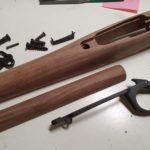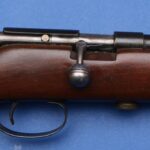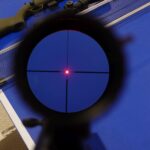There are many options when it comes to purchasing your first firearm. For me, I settled on the idea of purchasing a semi-auto rifle chambered in 22 LR. I reasoned that a 22 is cheap to feed, ammo is widely available, and it will help me learn the fundamentals of proper shooting techniques without breaking the bank. It’s the same advice that I give to all of my friends who are interested in getting into the shooting sports.
After completing my safety course and getting all the necessary paper work completed and sent off to Miramichi to be processed and while waiting for my license to come in the mail, I started researching my first purchase. I was amazed by all the different options out there, but I narrowed it down to a handful of choices: either a Remington 597, Ruger 10-22, Henry AR-7 survival rifle, or Marlin 795.
Once I had my license in hand, I made the snap decision for my first purchase, and that was a Remington 597. Sadly, I have buyers remorse when it came to the purchase of this rifle; right from day one it seemed to be plagued with feeding and extraction issues. The only time it would see any use would be when I brought it out for new shooters to try out. I would let them bang off rounds from the various 22’s that I own to let them get a feel for the different styles of firearms. However, I was embarrassed by how poorly the Remington 597 would function and the time came to purchase a functioning semi-auto 22 rifle to let new shooters to try out.
When the gun buy frenzy in the US slowed a little, I was able to source a Ruger 10/22 Carbine to replace my Remington 597. Finally, I had a 22 semi-auto rifle that, for a lack of a better phrase, just worked! It didn’t have the feeding and ejection issues that were seen with the my Remington 597, and the best part, unlike the Remington’s hi-cap magazines, the Butler Creek magazines for the Ruger 10-22 worked flawlessly.
Now, I don’t want to make this an article about all the flaws with my Remington 597, but instead, I want to talk about two of the most popular semi-auto repeaters on the market: the Remington 597 and Ruger 10/22. If you were to perform an informal survey of which rifle is the most popular, I think the Ruger would win hands down. Since both rifles are very popular, and I happen to own both of them, a comparison between the two is in order. I hope taking a look at the photos and watching the tear down and range videos of the guns helps you to make a decision on which one to buy.
Exterior features of the rifles
Both the Ruger 1022 Carbine and Remington 597 are semi-auto, detachable magazine feed rifles, each rifle is drilled and tapped for an optional optics rail. When I bought my Remington 597, it didn’t come with a optics rail, as it was an after market accessory that I had to purchase; unlike my Ruger 1022 which included the rail. I am running both rifles using the stock iron sights. The Ruger features a flipped down rear sight, which is a neat feature for those individuals that choose to run optics with a low profile mount. Both of the rear sights are adjusted by the use of a screw driver, loosening a screw, adjusting windage / elevation and then re-tightening the screw.
The safeties on the rifles are located in different spots; the Remington 597 is to the rear of the trigger group, while the Ruger 10-22 is forward of the trigger. The magazine releases are located in different spots as well; for the Remington it’s on the side of the firearm, just behind the magazine, inlaid into the stock, whereas the Ruger 10-22, its magazine release lever is just behind the magazine well.
When ready to shoot; with the Remington to chamber a round with the bolt locked back, all you need to do is insert a loaded magazine, pull back on the charging handle and release. This will drop the bolt and chamber your round. For the Ruger 10-22 to chamber a round with bolt locked back, you will have to insert the magazine, then pull back on the charging handle, while holding the charging handle back, at the same time pushing on the bolt release lever, which is located just behind and to the left of the magazine release, while holding the lever, release the bolt and a round will be chambered.
With the stocks removed from the firearms we can get a bit of closer look at the receivers and the internal components of the rifles.
The internals of the rifles – Lower Receiver, Upper Receiver and Bolts
The lower receiver for both firearms are retained in place using take down pins. The Remington 597 makes use of 1 pin located near the rear of the receiver and a small lip on the front of the lower receiver that fits into a notch on the upper receiver; the Ruger 1022 lower receiver uses 2 take down pins to be retained in place. One big difference you will notice between the firearms is the size of the lower receivers, as you can see the Remington 597 is much longer than the Ruger 1022. The extra length on Remington 597 is due to the magazine well being integrated into the lower receiver, for the Ruger 1022 magazine well is combined in both the lower and upper receiver.
Looking at the lower receivers side by side, you can see quite the difference in their hammers (please note, for the 597, I have already swapped the hammer with a Volquartsen Custom hammer). The surface area of the Ruger 1022 hammer is that much greater when compared to the Remington 597 hammer.
Another noticeable difference between the Ruger 1022 and Remington 597 is the internals of the upper receiver and the bolts. The Ruger 1022 bolt and guide rod, takes the K.I.S.S approach. The Ruger 1022, the guide rod, buffer spring and charging handle is integrated into one piece, unlike the Remington 597 which took a much different approach with their design. The Ruger 1022 bolt (with out stripping it down) is 2 parts: the bolt and guide rod assembly, versus the Remington 597, which is 8 pieces. For the Remington 597, there is the bolt, the two bolt guides, two buffer springs, two screws that hold the guide rods in place (not pictured) and the charging handle. For the Ruger 1022 to hold the bolt in place inside the receiver, it is uses the notch on the bolt for the charging handle and a small notch on the top the receiver; the bolt on the Remington 597 is retained in place by the guide rods inside the receiver.
Comparing the bolts, the Ruger 1022 is much longer, but not as tall as the Remington 597. Additionally, the firing pin for the Ruger 1022 is located on the top of the bolt, unlike the Remington 597 which runs through the bolt. One thing to note looking at the picture is the extractor; if you look at the bolt face, the extractor for the Ruger 1022 is located at the 7 o’clock positions, compared to that of the Remington 597, which is located at more the 9 o’clock position.
The Magazines
The last big difference between the the two rifles are the stock magazines. The Ruger 1022 uses a rotatory magazine, it’s just like it sounds, as you load up the magazine, the rounds will rotate in the magazine body kind of like winding up a clock and as you’re shooting, the rounds will rotate through the magazine. The Remington 597 utilizes a stick magazine, this is very traditional design, where it’s a straight magazine body with a follower, spring, and floor plate.
The last item worth mentioning about the magazines is that with the Remington 597, the rifle has a last round bolt hold open, unlike the Ruger 1022. Once you’re done discharging your ammunition, the Ruger 10/22 bolt will travel forward on an empty chamber. To lock the bolt open on a Ruger 1022, much like releasing it, you will have to pull back the charging handle, until the bolt is in the rearward position, and then while holding the bolt back, press and hold the bolt release lever, while releasing the charging handle, to lock the bolt in place.
Tear down and discussion / with a range visit
http://www.youtube.com/watch?v=x1Ezmotlt4Y
http://www.youtube.com/watch?v=eYPTjRxkiME
In the range video comparing the Ruger 1022 to the Remington 597, I had a lot of feeding and extracting issues with my Remington 597, but in a later video, and a future article, I will discuss some of the work that I did to optimize the rifle and finally make mine work the way it should. If you’re looking for a rifle where there are hundreds of different accessories for it, as well as after market parts (there are enough parts for the Ruger 1022 you can build a complete gun using only spare parts) then the Ruger 1022 is the rifle to go with. Now, the Remington 597 isn’t a bad gun, but it may require some fine tuning to get them to run right.



























